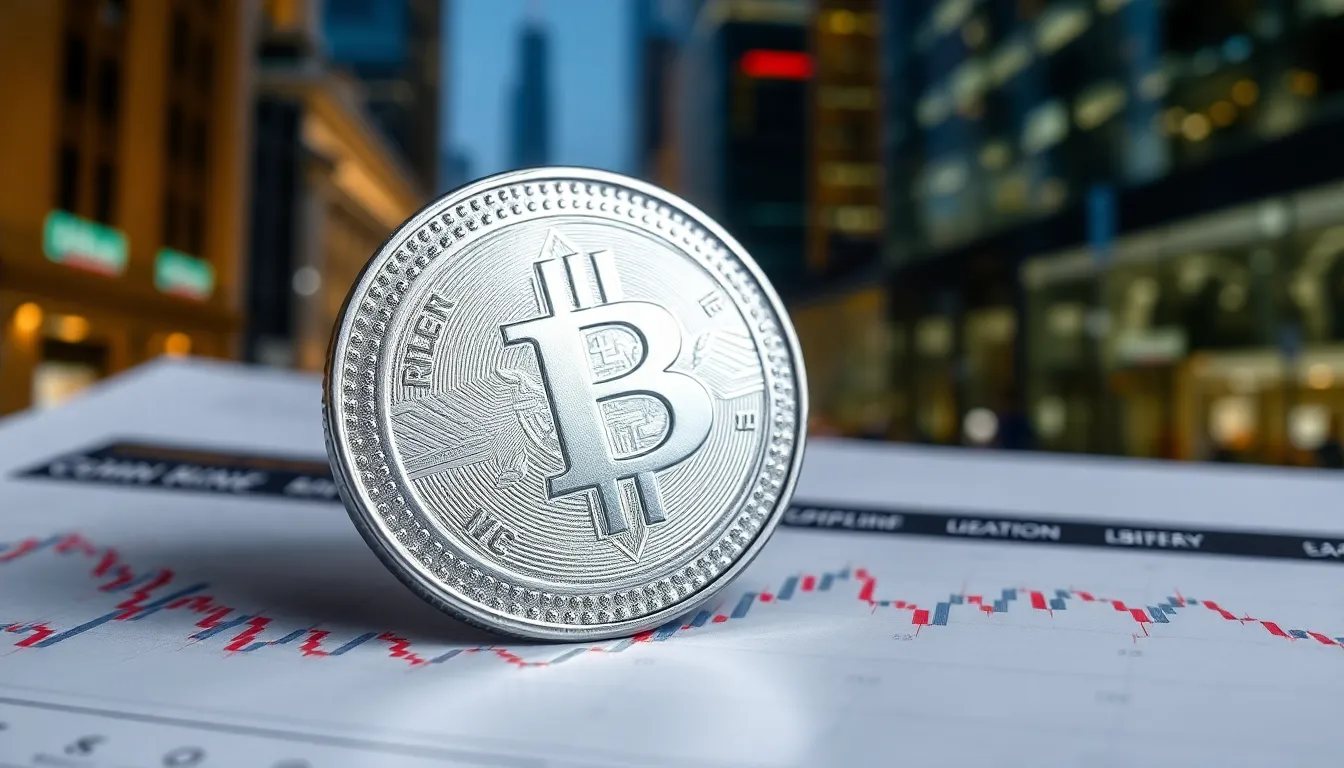Silver, the shiny metal that’s been a favorite for jewelry and investment alike, is grabbing attention as investors ponder its future. With the market constantly shifting, predicting silver prices can feel like trying to catch a greased pig at a county fair. But fear not! Armed with the right insights, anyone can navigate this slippery terrain.
As the world grapples with economic uncertainties and inflation fears, silver’s role as a safe haven is more crucial than ever. Will it skyrocket or plummet? The crystal ball may be a bit foggy, but trends and expert opinions can shed light on what lies ahead. Buckle up as we dive into the fascinating world of silver price predictions and uncover what might be in store for this precious metal.
Table of Contents
ToggleUnderstanding Silver Prices
Silver prices fluctuate due to multiple factors, including supply and demand dynamics, economic conditions, and geopolitical events. Investors observe these variables closely, recognizing how they influence market behavior. High demand in industries such as electronics and solar energy often drives prices upward. Conversely, increased mining outputs can put downward pressure on prices.
Market analysts pay attention to economic indicators like inflation rates and currency strength. Inflation typically boosts interest in silver as a hedge against currency devaluation. Similarly, the US dollar’s performance significantly impacts silver prices; a weaker dollar often results in higher silver values.
Geopolitical tensions also contribute to silver’s volatility. For example, uncertainty from global conflicts tends to prompt investors toward safe-haven assets, driving silver prices higher. Historical trends reveal this pattern.
Central banks’ policies further influence silver pricing strategies. Changes in interest rates can either support or hinder investment in precious metals. Often, low-interest rates encourage higher investment, while rate hikes may diminish silver’s appeal.
Seasonal demand variations also impact prices. Jewelry demand peaks during festive seasons, typically raising prices. Market sentiment can shift rapidly, influenced by news events or economic reports, creating opportunities for savvy investors.
Experts suggest tracking the silver-to-gold ratio, which often signals price movements. A higher ratio might indicate potential undervaluation in silver, while a lower ratio could suggest price spikes ahead. By analyzing these indicators and trends, one gains a clearer understanding of potential future silver price movements.
Factors Influencing Silver Prices

Several factors affect silver prices, making them dynamic and complex. Economic conditions play a pivotal role, as they directly influence investor behavior and demand for silver.
Economic Indicators
Inflation rates significantly impact silver investment decisions. When inflation rises, investors often turn to silver as a hedge against currency devaluation. Interest rates set by central banks also shape silver prices. Lower interest rates tend to increase the appeal of precious metals, including silver, as they offer no yield. Economic indicators such as GDP growth and employment rates further guide market sentiment and silver pricing. Analysts frequently monitor these figures to anticipate potential price shifts.
Market Demand and Supply
Market demand for silver fluctuates based on industrial usage and investment appetite. Industries such as electronics and solar energy drive significant demand, affecting pricing positively. While increased manufacturing may boost demand, unexpected mining discoveries can lead to oversupply. When supply outpaces demand, prices typically fall. Seasonal events, like holidays, can create short-term spikes in jewelry demand, further impacting prices. Understanding these dynamics is essential for recognizing trends in silver pricing.
Geopolitical Events
Geopolitical tensions create uncertainty, prompting investors to seek safe-haven assets like silver. Conflicts and political instability often correlate with increased silver demand. Changes in policies or sanctions can also disrupt supply chains, adding volatility to prices. As events unfold globally, they heavily influence market reactions. Investors must stay informed on geopolitical developments to gauge their potential impact on silver prices.
Historical Performance of Silver
Silver prices exhibit significant volatility due to various historical factors. From 2000 to 2011, a notable upward trend occurred, with prices surging from around $4.00 per ounce to approximately $48.00 per ounce. This period coincided with heightened demand for silver in industrial applications and jewelry markets.
Throughout 2011, after reaching a peak, silver experienced a sharp decline, falling to about $14.00 per ounce by late 2015. Factors contributing to this decline included a strengthening US dollar and lower industrial demand. Analysts observed that in the following years, a gradual recovery began, with prices stabilizing around $15.00 to $20.00 per ounce.
The period from 2016 to 2020 saw fluctuations that resulted from renewed interest in precious metals as investment assets. Economic uncertainty, coupled with global events such as the COVID-19 pandemic, lifted silver prices significantly. In July 2020, silver reached a high of approximately $29.00 per ounce, driven by fears of inflation and currency devaluation.
Historically, price movements correlate closely with geopolitical tensions. Conflicts and economic crises trigger increased demand for safe-haven assets, including silver. In 2008 during the financial crisis, silver prices reflected investor behavior, rising in response to market uncertainty.
Investors closely monitor the silver-to-gold ratio to gauge market conditions. This indicator helps in assessing silver’s relative value. For example, a ratio above 80 often signals undervaluation, while a ratio below 50 may predict price surges. Understanding these historical patterns aids in forecasting future market behavior and potential price movements.
Expert Predictions for Future Silver Prices
Experts actively analyze several factors to forecast silver prices. Market trends, economic indicators, and geopolitical tensions shape the outlook.
Short-Term Predictions
Analysts expect silver prices to experience volatility in the near term. Increased demand from the electronics and solar energy sectors may drive prices higher. A significant rise in inflation could lead investors to seek silver as a hedge against currency devaluation. Additionally, fluctuations in the US dollar heighten uncertainty, impacting short-term movements. Specific forecasts suggest prices may range between $22.00 and $25.00 per ounce over the next few months, reflecting the influence of economic data releases and market sentiment.
Long-Term Predictions
Long-term predictions indicate a more bullish outlook for silver. Demand for industrial applications and renewable energy solutions is projected to grow, with silver playing a crucial role. Experts foresee potential prices reaching $30.00 or more per ounce by the end of the decade, driven by sustained interest and geopolitical risks. Historical performance shows that strong market demand often leads to bullish trends, particularly during economic downturns. Investors might monitor the silver-to-gold ratio closely, as shifts in this ratio can provide insights into future price movements.
Investment Strategies for Silver
Investors often consider various strategies when entering the silver market. Understanding market conditions plays a crucial role in timing purchases. Buying silver during price dips allows for potential higher returns when prices rebound.
Investors might focus on physical silver such as coins and bars. This tangible form provides a sense of security against economic instability. Additionally, silver exchange-traded funds (ETFs) offer a convenient way to gain exposure without needing to store physical metals. Experts recommend researching reputable ETFs for the best results.
Diversification is key in any investment strategy. Including silver in a broader portfolio can hedge against inflation and economic uncertainty. Allocating 10% to 20% of an investment portfolio to precious metals may enhance overall returns.
Monitoring the silver-to-gold ratio can also guide investment decisions. A high ratio may indicate that silver is undervalued compared to gold. Investing when the ratio leans heavily toward gold could yield better opportunities.
Seasonal trends impact silver prices, particularly around holidays. Increased jewelry demand during specific months may drive prices higher. Recognizing these patterns allows for more strategic buying and selling.
Utilizing market analysis tools supports informed decision-making. Charting historical price movements and current trends provides insight into future fluctuations. Staying updated on economic indicators is vital for successful investments in silver.
Investors should remain aware of geopolitical events, which can lead to spikes in demand. Political instability often triggers shifts toward safe-haven assets, including silver. This awareness enables smarter investment timing.
The future of silver prices remains uncertain yet promising. With ongoing economic challenges and geopolitical tensions, silver’s role as a safe haven continues to attract investor interest. Short-term volatility is expected but long-term forecasts suggest potential price increases driven by industrial demand and inflation concerns.
Investors should remain vigilant and consider market indicators such as the silver-to-gold ratio to navigate price movements effectively. By staying informed and adopting strategic investment approaches, they can position themselves to capitalize on silver’s evolving landscape. As trends unfold, silver may prove to be a valuable asset in a diversified portfolio.




